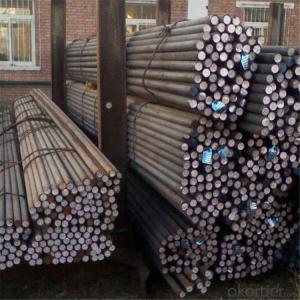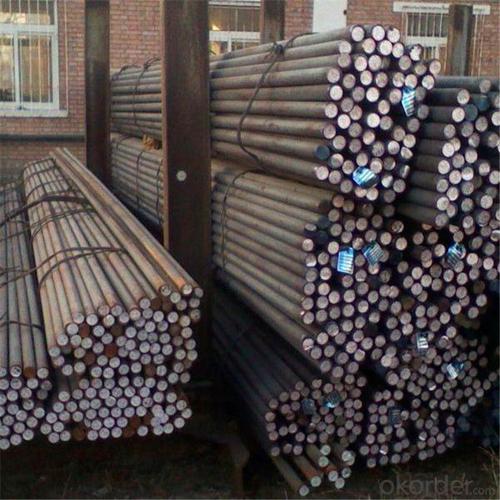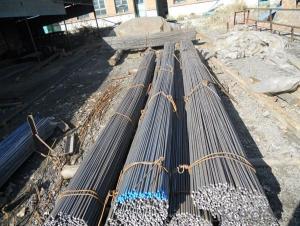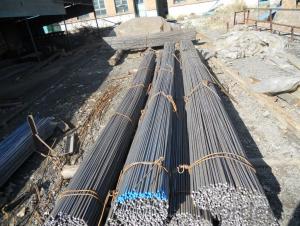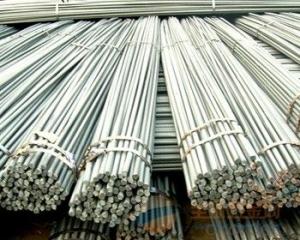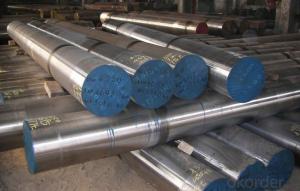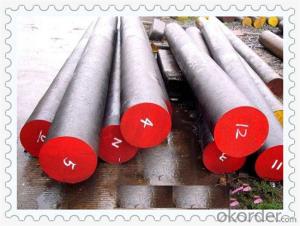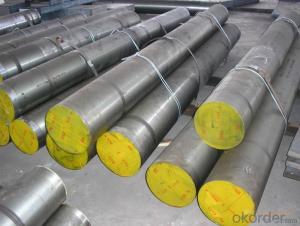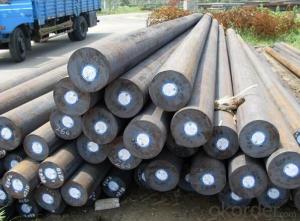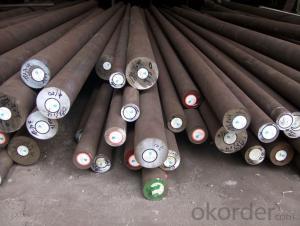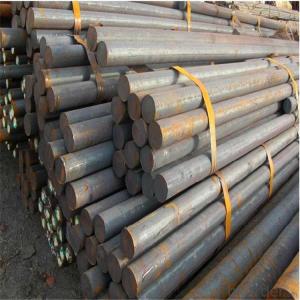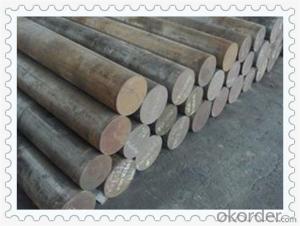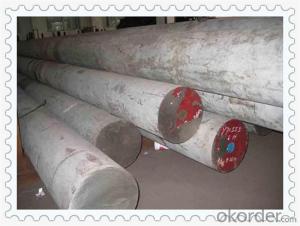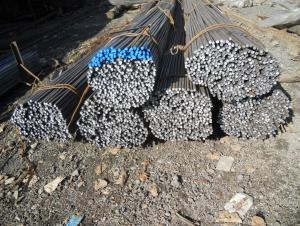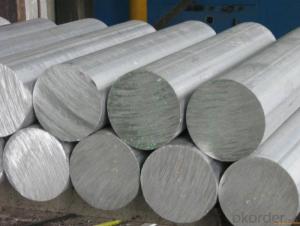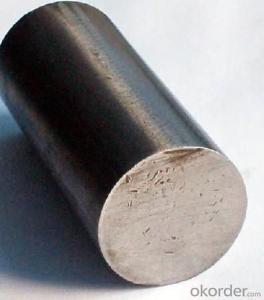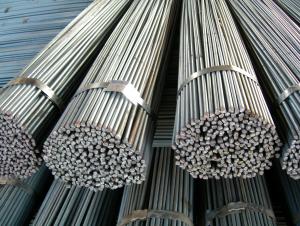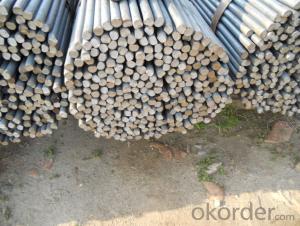Hot Rolled S45C ASTM4140 Alloy Steel Round Bar
- Loading Port:
- Tianjin
- Payment Terms:
- TT OR LC
- Min Order Qty:
- 100 m.t.
- Supply Capability:
- 500000 m.t./month
OKorder Service Pledge
OKorder Financial Service
You Might Also Like
Specification
Hot Rolled S45C ASTM4140 Alloy Steel Round Bar
Product Description of Hot Rolled S45C ASTM4140 Alloy Steel Round Bar
1. Steel grade: SAE1045, 45#, C45, S45C
2. Length: 6M-12M
3. Diameter: 16mm-300mm
4. Product range: round bar, flat bar, square bar
5. Technique: Hot rolled, forged, cold drawn
Specification of Hot Rolled S45C ASTM4140 Alloy Steel Round Bar
Material | S45C ASTM4140 | 16-300mm | ||
Process | EAF + LF + VD + Forged + Heat Treatment (optional) | Length (mm) | Max 12m | |
Heat treatment | Normalized / Annealed / Quenched / tempered | Flat bar | Thickness(mm) | 8-500mm |
Delivery condition | Hot forged +Rough machined (black surface after Q/T)+ Turned (optional) | Width(mm) | 70-200mm | |
Test | Ultrasonic test according to SEP 1921-84 D/d | Length (mm) | Max 12m |
Chemical Composition of Hot Rolled S45C ASTM4140 Alloy Steel Round Bar
C | Si | Mn | Cr | Ni | Cu |
0.40~0.49 | 0.17~0.37 | 0.35~0.65 | ≤0.25 | ≤0.30 | ≤0.25 |
Photo Show of Hot Rolled S45C ASTM4140 Alloy Steel Round Bar
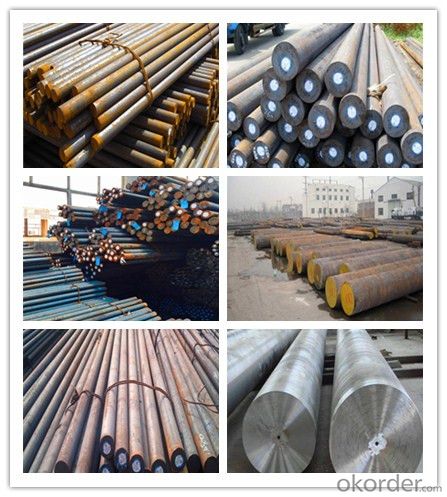
Packing and Delivery:
Packing in bundle package, or as customer's requirements.
Delivery Detail: 45 days after receiving the deposit.
Usage and Applications of Hot Rolled S45C ASTM4140 Alloy Steel Round Bar
1. Steel round bar is used in a large number of architectural and engineering structures. Or it can be used in construction of plants for the production of steel house frames, high-voltage transmission towers, bridges, vehicles, boilers, containers, ships, etc.
2. And we can use this kind of product on the performance of the mechanical parts if the demand is not very high.
3. Some special material steel round bar can be used for main shaft of steamer, hummer shank, with big section and supper force.
Company Information
CNBM International Corporation is the most important trading platform of CNBM group.
Whith its advantages, CNBM International are mainly concentrate on Cement, Glass, Iron and Steel, Ceramics industries and devotes herself for supplying high qulity series of refractories as well as technical consultancies and logistics solutions.

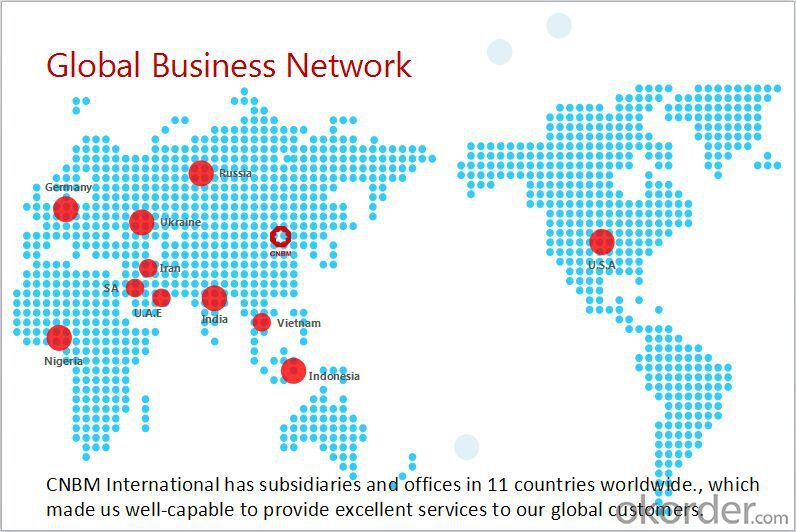
F A Q
1, Your advantages?
professional products inquiry, products knowledge train (for agents), smooth goods delivery, excellent customer solution proposale
2, Test & Certificate?
SGS test is available, customer inspection before shipping is welcome, third party inspection is no problem
3, Factory or Trading Company?
CNBM is a trading company but we have so many protocol factories and CNBM works as a trading department of these factories. Also CNBM is the holding company of many factories.
4, Payment Terms?
30% TT as deposit and 70% before delivery.
Irrevocable L/C at sight.
5, Trading Terms?
EXW, FOB, CIF, FFR, CNF
6, After-sale Service?
CNBM provides the services and support you need for every step of our cooperation. We're the business partner you can trust.
For any problem, please kindly contact us at any your convenient time.
We'll reply you in our first priority within 24 hours.
- Q: Can steel round bars be used for making steering linkages?
- Yes, steel round bars can be used for making steering linkages. Steel round bars are commonly used in various applications, including automotive and mechanical engineering, due to their high strength, durability, and resistance to wear and tear. Steering linkages are critical components in a vehicle's steering system, responsible for transmitting steering input from the steering wheel to the wheels. The use of steel round bars provides the necessary strength and rigidity required to ensure efficient and reliable steering performance. However, it is important to consider other factors such as the specific design requirements, weight considerations, and the desired level of flexibility or torsional properties when selecting the appropriate type and size of steel round bar for steering linkages.
- Q: Can steel round bars be used in the manufacturing of gears?
- Yes, steel round bars can be used in the manufacturing of gears. Steel round bars are commonly used in gear manufacturing due to their high strength, durability, and resistance to wear and tear. The round shape of the bar allows for easy machining and shaping into the desired gear design. Steel round bars also have excellent mechanical properties, such as high tensile strength and good fatigue resistance, which are essential for gears that experience heavy loads and repetitive motions. Additionally, steel round bars can be heat-treated to further enhance their hardness and toughness, making them suitable for demanding gear applications. Overall, steel round bars are a popular choice in gear manufacturing due to their versatility and reliability.
- Q: How do you measure the diameter tolerance of a steel round bar?
- To determine the diameter tolerance of a steel round bar, one can adhere to the following procedure: 1. Acquire a caliper or micrometer, which are commonly employed tools for accurately gauging object diameters. 2. Set up the measuring tool appropriately: Adjust the jaws of the caliper to the suitable size range or ensure correct zeroing of the micrometer. 3. Situate the round bar: Place the steel round bar on a stable and flat surface, taking care to prevent any rolling or movement. 4. Perform the measurement: Utilize the measuring tool to record the diameter of the round bar. For precise outcomes, ensure that the tool is perpendicular to the bar and exert gentle pressure to obtain an accurate reading. 5. Repeat the measurement: To ensure accuracy, take multiple measurements at various points along the length of the round bar. This will account for any variations or deviations in the bar's diameter. 6. Calculate the average diameter: Sum up all the measurements and divide by the number of measurements taken. This will yield the average diameter of the round bar. 7. Compare with the tolerance range: Refer to the provided specifications or standards for the steel round bar to ascertain the allowable tolerance range. This range will indicate the acceptable variation in diameter for the bar. 8. Analyze the findings: Compare the average diameter derived from the measurements with the specified tolerance range. If the average diameter falls within the tolerance range, the round bar complies with the required specifications. However, if it deviates beyond the range, further inspection or adjustment may be necessary to meet the required tolerance. By adhering to these steps, one can effectively gauge the diameter tolerance of a steel round bar and ensure its conformity to the necessary specifications for the intended application.
- Q: Can steel round bars be used in structural applications?
- Steel round bars are suitable for structural applications and commonly utilized in construction and engineering projects that prioritize strength and durability. They offer versatility and can function as beams, columns, and supports for various structural elements. Thanks to their exceptional mechanical properties, such as high tensile strength and good ductility, they can withstand heavy loads and resist deformation effectively. Moreover, their easy joinability to other structural components contributes to their popularity within the construction industry.
- Q: What are the advantages of using heat-treatable steel round bars?
- There are several advantages of using heat-treatable steel round bars: 1. Increased strength: Heat-treatable steel round bars can be subjected to controlled heating and cooling processes, which enhances their strength and hardness. This makes them suitable for applications that require high strength and durability. 2. Improved wear resistance: Through heat treatment, the steel round bars can develop a hardened surface layer, which significantly improves their resistance to wear and abrasion. This makes them ideal for use in industries such as manufacturing, construction, and automotive, where components are subjected to heavy wear and tear. 3. Customizability: Heat-treatable steel round bars offer the advantage of being easily customizable to meet specific requirements. By adjusting the heat treatment process, the hardness, strength, and other mechanical properties of the bars can be tailored to suit different applications, ensuring optimal performance. 4. Machinability: Heat-treatable steel round bars typically have good machinability, which means they can be easily cut, drilled, or shaped into various forms without compromising their structural integrity. This makes them convenient to work with, reducing production time and costs. 5. Versatility: Heat-treatable steel round bars are highly versatile and find applications in a wide range of industries, including construction, manufacturing, oil and gas, automotive, and aerospace. They are commonly used in the production of shafts, gears, bolts, axles, and other critical components. 6. Cost-effectiveness: While heat-treatable steel round bars may have a higher initial cost compared to non-heat-treatable or lower-grade steels, their durability and enhanced properties make them cost-effective in the long run. The improved strength and wear resistance lead to longer service life, reducing the need for frequent replacements and maintenance. Overall, the advantages of using heat-treatable steel round bars include increased strength, improved wear resistance, customizability, good machinability, versatility, and cost-effectiveness. These benefits make them a preferred choice for demanding applications that require high-performance materials.
- Q: What is the difference between hot working and cold working of steel round bars?
- Hot working and cold working are two different methods used to shape and manipulate steel round bars. Hot working involves heating the steel to a high temperature, typically above its recrystallization temperature, and then shaping it through processes such as forging, rolling, or extrusion. This method helps to reduce the hardness and increase the ductility of the steel, making it easier to reshape and form into desired shapes. Hot working also helps to refine the grain structure of the steel, improving its mechanical properties. On the other hand, cold working is performed at or near room temperature without the need for heating the steel. It involves processes like cold rolling, drawing, or bending, where the steel is mechanically deformed to achieve the desired shape. Cold working increases the strength and hardness of the steel while reducing its ductility. It also causes strain hardening, which results in a finer grain structure and improved dimensional accuracy. In summary, the main difference between hot working and cold working of steel round bars lies in the temperature at which the processes are carried out and the resulting effects on the mechanical properties of the steel. Hot working is performed at high temperatures to increase ductility and refine grain structure, while cold working is done at or near room temperature to enhance strength, hardness, and dimensional accuracy.
- Q: What are the different types of steel round bar surface treatments?
- There are several different types of surface treatments that can be applied to steel round bars to enhance their appearance, durability, and resistance to corrosion. Some of the most common surface treatments include: 1. Hot-dip galvanizing: This process involves immersing the steel round bar in a bath of molten zinc to create a protective zinc coating. This coating helps to prevent rust and corrosion, making it ideal for outdoor applications. 2. Electroplating: Electroplating involves coating the steel round bar with a layer of another metal, such as chrome or nickel. This not only enhances the appearance of the bar but also improves its resistance to corrosion. 3. Powder coating: In this process, a dry powder is applied to the surface of the steel round bar electrostatically and then cured under heat. This creates a hard, durable, and attractive finish that is resistant to chipping, scratching, and fading. 4. Passivation: Passivation is a chemical process that removes impurities from the surface of the steel round bar, leaving behind a clean and corrosion-resistant layer. This treatment is commonly used for stainless steel bars to enhance their resistance to rust. 5. Black oxide coating: Black oxide coating is a conversion coating that forms a thin layer of black iron oxide on the surface of the steel round bar. This treatment provides mild corrosion resistance and also gives the bar a sleek black appearance. 6. Shot blasting: Shot blasting involves propelling abrasive materials at high speeds onto the surface of the steel round bar to remove any impurities or scale. This treatment not only improves the appearance but also creates a roughened surface that promotes better adhesion of coatings. 7. Acid pickling: Acid pickling is a process that removes scale and impurities from the surface of the steel round bar by immersing it in an acid bath. This treatment leaves the surface clean and free from any contaminants. These are just a few examples of the various surface treatments available for steel round bars. The choice of treatment depends on factors such as the intended use of the bar, the desired appearance, and the level of corrosion resistance required.
- Q: How are steel round bars tested for quality and compliance?
- Steel round bars are tested for quality and compliance through a series of rigorous tests and inspections to ensure they meet the required standards and specifications. One of the most common tests used is the tensile test, which measures the bar's ability to withstand pulling forces. This test involves stretching the bar until it breaks and analyzing the stress-strain curve to determine its mechanical properties, such as yield strength, ultimate tensile strength, and elongation. Another important test is the hardness test, which measures the resistance of the bar's surface to indentation. This test helps determine the material's strength and its ability to resist wear and deformation. Chemical analysis is also conducted to verify the composition of the steel round bars. This test determines the percentage of elements present in the steel, such as carbon, manganese, silicon, sulfur, and phosphorus. It ensures that the steel is made according to the required specifications and is suitable for the intended application. Dimensional inspection is crucial to ensure that the steel round bars meet the specified dimensions and tolerances. This involves measuring the length, diameter, and straightness of the bars using calibrated instruments. Surface quality is assessed through visual inspection and non-destructive testing methods, such as ultrasonic testing and magnetic particle inspection. These tests detect any surface defects, cracks, or discontinuities that may affect the bar's performance and integrity. In addition to these tests, steel round bars may undergo other specialized tests based on their intended application. For example, bars used in the construction industry may be subjected to corrosion resistance or impact testing. Overall, the quality and compliance of steel round bars are ensured through a comprehensive range of tests, inspections, and analyses. These tests help manufacturers and customers determine the suitability and reliability of the bars for specific applications, ensuring the safety and effectiveness of the final products.
- Q: How do you prevent warping during welding of steel round bars?
- To prevent warping during welding of steel round bars, several measures can be taken. Firstly, it is crucial to ensure proper fit-up and alignment of the bars before welding, as any misalignment can lead to distortion. Secondly, using an appropriate welding technique, such as back-stepping or stitch welding, can help distribute heat evenly and minimize warping. Additionally, controlling the heat input and avoiding excessive heat buildup by using intermittent welding or preheating can also prevent distortion. Lastly, the use of clamps, fixtures, or tack welds to secure the bars in place during welding can provide stability and reduce the chances of warping.
- Q: What are the advantages of using maraging steel round bars?
- There are several advantages of using maraging steel round bars in various applications. 1. High strength: Maraging steel round bars have an exceptionally high strength-to-weight ratio, making them ideal for applications where strength is crucial. These bars can withstand high stress and load-bearing conditions without deformation or failure, ensuring structural integrity. 2. Superior toughness: Maraging steel round bars exhibit excellent toughness, which means they can absorb a significant amount of energy before fracturing. This property makes them highly resistant to cracking or breaking, even under extreme conditions, enhancing their durability and reliability. 3. Corrosion resistance: Maraging steel round bars are known for their exceptional corrosion resistance. They are less susceptible to rust and oxidation compared to other types of steel, making them suitable for applications in harsh environments or where exposure to moisture or chemicals is a concern. This corrosion resistance helps prolong the lifespan of the bars and reduces maintenance costs. 4. Machinability: Maraging steel round bars are relatively easy to machine, despite their high strength and hardness. They can be readily shaped, drilled, and cut into various forms and sizes, allowing for versatile applications across different industries. This ease of machining saves time and effort during the manufacturing process. 5. Heat treatability: Maraging steel round bars have excellent heat treatability, meaning they can be hardened and tempered to further improve their mechanical properties. This flexibility in heat treatment allows for customization to meet specific project requirements, such as achieving desired hardness levels or enhancing specific characteristics like wear resistance or toughness. 6. Aerospace and defense applications: Maraging steel round bars are widely used in aerospace and defense industries due to their exceptional strength, toughness, and corrosion resistance. They are commonly employed in the manufacturing of critical components like landing gear, missile casings, and aircraft structures, where reliability and performance are of utmost importance. Overall, the advantages of using maraging steel round bars include their high strength, superior toughness, corrosion resistance, machinability, heat treatability, and suitability for aerospace and defense applications. These properties make them a preferred choice for various demanding industries and ensure optimal performance and longevity in critical applications.
Send your message to us
Hot Rolled S45C ASTM4140 Alloy Steel Round Bar
- Loading Port:
- Tianjin
- Payment Terms:
- TT OR LC
- Min Order Qty:
- 100 m.t.
- Supply Capability:
- 500000 m.t./month
OKorder Service Pledge
OKorder Financial Service
Similar products
Hot products
Hot Searches
Related keywords
